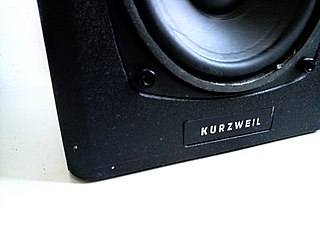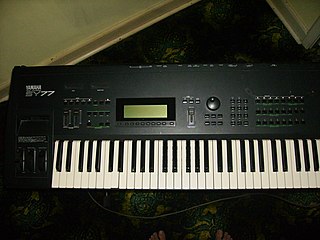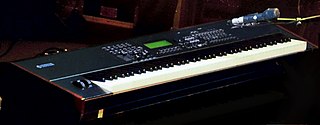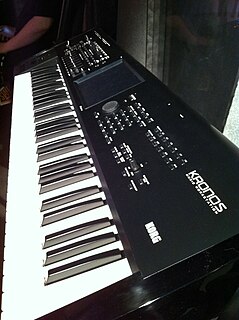Related Research Articles

Kurzweil Music Systems is an American company that produces electronic musical instruments. It was founded in 1982 by Stevie Wonder (musician), Raymond Kurzweil (innovator) and Bruce Cichowlas.
Electone is the trademark used for electronic organs produced by Yamaha. With the exception of the top end performance models, most Electones are based on the design on the spinet electronic organ. Current models are completely digital and contain a variety of sounds, effects, and accompaniments, on top of the ability to store programming data onto memory devices.

A stage piano is an electronic musical instrument designed for use in live performance on a stage or a studio, as well as for music recording in jazz and popular music. While stage pianos share some of the same features as digital pianos designed for home use and synthesizers, they have a number of features which set them apart. Stage pianos usually provide a smaller number of sounds, with these sounds being of higher quality, unlike regular digital pianos and home synthesizers.

The Yamaha RM1x is a groovebox manufactured by Yamaha from 1999 to 2002. It integrates several, commonly separate, pieces of music composition and performance hardware into a single unit: a step-programmable drum machine, a synthesizer, a music sequencer, and a control surface.

The Yamaha Motif is a series of music workstation synthesizers, first released by Yamaha Corporation in August 2001. The Motif replaced the EX series in Yamaha's line-up. Other workstations in the same class are the Korg Kronos and the Roland Fantom G.

The Korg Trinity is a synthesizer music workstation released by Korg in 1995. It was also the first workstation to offer modular expansion for not only sounds, but also studio-grade feature such as SCSI, ADAT, various sound engine processors, audio recording capability, and more. It was considered one of the most comprehensive music workstations, in term of features, at the time.

The Ensoniq AudioPCI is a PCI-based sound card released in 1997. It was Ensoniq's last sound card product before they were acquired by Creative Technology. The card represented a shift in Ensoniq's market positioning. Whereas the Soundscape line had been made up primarily of low-volume high-end products full of features, the AudioPCI was designed to be a very simple, low-cost product to appeal to system OEMs and thus hopefully sell in mass quantities.

The discontinued Roland MC-909 Sampling Groovebox combines the features of a synthesizer, sequencer, and sampler, with extensive hands-on control of both the sound engine and the sequencing flow. It was intended primarily for live performance of pre-programmed patterns consisting of up to 16 tracks of MIDI data. It was released by Roland Corporation on October 8, 2002. This product was announced at the AES Fall Convention in 2002. It is the direct successor to the Roland MC-505, and is the predecessor to the Roland MC-808 which eventually ended the "Groovebox" line of products by Roland which began in the mid 1990s with the original MC-303. It was developed from the blueprint of Roland's own "Fantom" workstation and uses the same structure and operating system, with some differences regarding the Patterns section, not implemented in the Fantom.
The Fantom-X (Xa/X6/X7/X8/XR) is a music workstation/synthesizer produced by Roland Corporation. It was introduced in 2004 as an upgrade from the Fantom S series. The Fantom-X competes with the Korg Triton/Triton Extreme, the Yamaha Motif ES and other similar large-scope keyboards such as the discontinued Alesis Fusion. In 2008 it was succeeded by the Fantom-G, which was devised to compete with the new Korg and Yamaha flagship keyboards.
The Yamaha SY85 is a digital music workstation introduced in 1992. Unlike other Yamaha synthesizers of the time the SY85 does not use FM synthesis. Instead, its sounds are based on samples, which can be layered and modified to create new sounds.

The Yamaha CS2x is a sample-based synthesizer released by the Yamaha Corporation in 1999. The CS2x is designed for maximum real-time control, according to Yamaha. It is the successor of the very successful Yamaha CS1x. Enhancements include 64-note polyphony, a bigger sample ROM and a 24 dB/oct LPF/HPF filter. The CS acronym stands for Control Synthesizer.

Yamaha SY77 is a 16 voice multitimbral music workstation first produced by Yamaha Corporation in 1989. The SY77 is a synthesizer whose architecture combines AFM synthesis, AWM2 for ROM-borne sample-based synthesis, and the combination of these two methods christened Realtime Convolution and Modulation Synthesis (RCM). The same technology was also packaged in a rack-mounted module released simultaneously, the TG77.

The Yamaha MM6 is a compact synthesizer manufactured by the Yamaha Corporation, and was first introduced in January 2007. The MM6 includes fairly high quality samples for the price of the keyboard, however it is still a professional level piece of equipment. The default samples that is provided on board the MM6 are based on the Yamaha Motif series workstation sound sets. This keyboard comes with 418 patches, and 22 drum kits, all based upon those that available with the Motif series workstations.

The Yamaha Music SynthesizerS90 is a synthesizer and a MIDI controller in one unit, released in 2002 to supersede the S80. As such, it is part of the S series together with the S03 and S08. It was superseded by the S90ES in 2005, itself superseded by the S90XS in 2009.

The Yamaha DX1 is the top-level member of Yamaha's prolific DX series of FM synthesizers.
Julian Colbeck is current CEO of Keyfax NewMedia and a former professional keyboard player of over 25 years, author of several music-related books and guides, the creator of Twiddly.Bits MIDI loops, the concept designer for the PhatBoy MIDI controller, and producer of several music technology DVDs and websites. He has played/collaborated with Greep, The New Seekers, Charlie, John Miles, Yes offshoot Anderson Bruford Wakeman Howe, and Genesis guitarist Steve Hackett. He also worked as a session player on numerous recordings, including the debut Vitamin Z album, produced by Alan Parsons, with whom he would later collaborate on the 2009 DVD set, Alan Parsons' The Art & Science of Sound Recording.

The Kronos is a music workstation manufactured by Korg that combines nine different synthesizer sound engines with a sequencer, digital recorder, effects, a color touchscreen display and a keyboard. Korg's latest flagship synthesizer series at the time of its announcement, the Kronos series was announced at the winter NAMM Show in Anaheim, California in January 2011.

The Yamaha DX21 is a digital bi-timbral programmable algorithm synthesizer with a four operator synth voice generator which was released in 1985. It uses sine wave-based Frequency Modulation (FM) synthesis. It has two FM tone generators and a 32-voice Random Access Memory (RAM), 32 user voices and 128 Read Only Memory (ROM) factory preset sounds. As a programmable synth, it enables users to create their own unique synthesized tones and sound effects by using the algorithms and oscillators. The instrument weighs 8 kg (17.6 lbs). On its release, it sold for $795.
References
- ↑ "Yamaha M06". Sound On Sound. June 2006. Archived from the original on 6 September 2015.